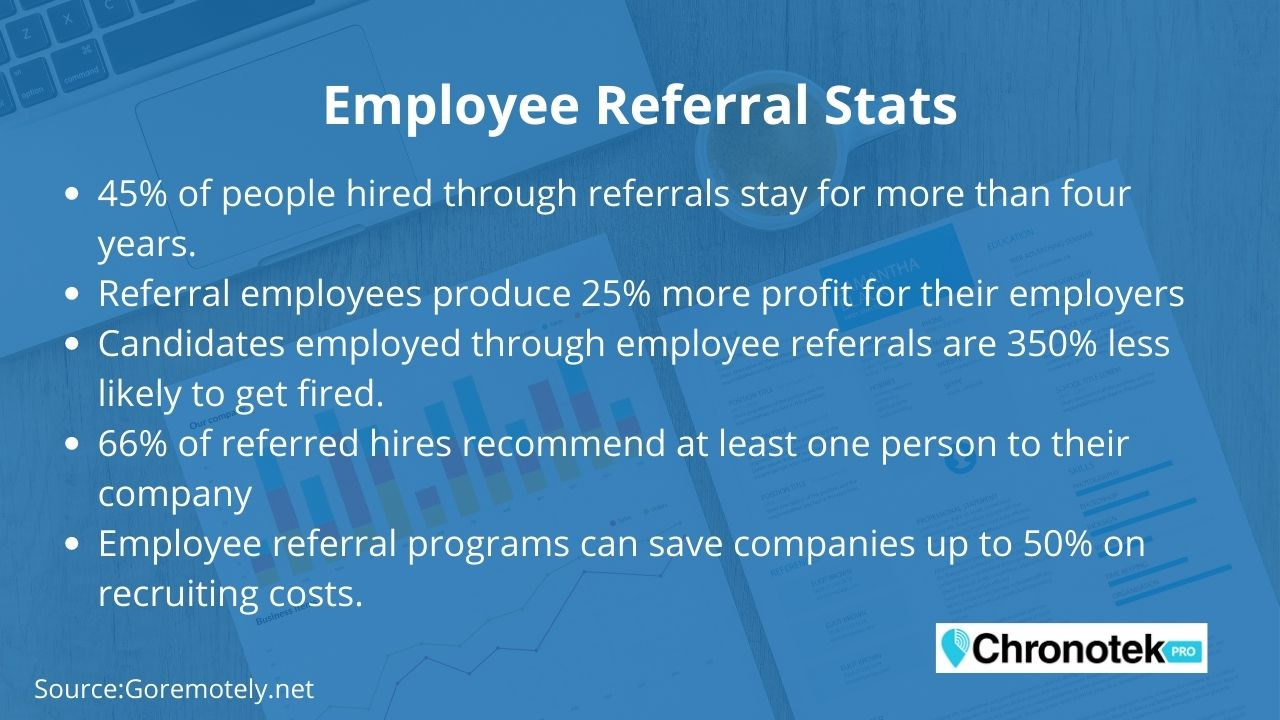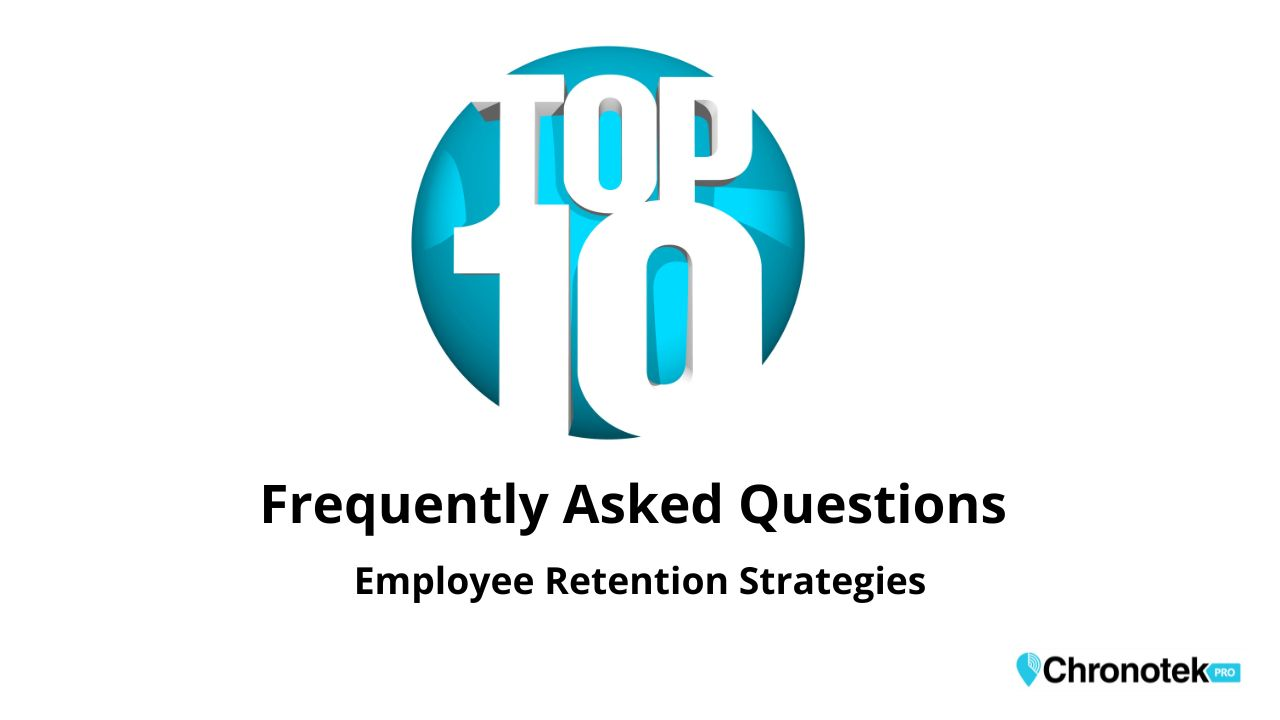Top 10 Employee Retention Strategies to Keep Your MVPs Happy

In a world where the best workers are highly sought-after, keeping your ace employees is as crucial as attracting them in the first place. A small business's ability to hold onto its skilled workforce speaks volumes about its company culture, leadership quality, and overall appeal as an employer. But how do you foster an environment that makes employees decide to stick around for the long haul? What are the best employee retention ideas to help you achieve this? Get ready for a deep dive into understanding employee turnover and discovering innovative strategies that can boost employee retention and contribute to your company's long-term success.
Short Summary
-
Understand why employees leave and create an effective retention strategy to reduce turnover.
-
Foster a supportive company culture with collaboration, rewards & recognition, flexible work schedules, and professional development opportunities.
-
Measure success through surveys, productivity levels & turnover rates for informed decisions on employee retention.
Table of Contents
- Understanding Employee Turnover
- The Benefits of Reducing Employee Turnover
- What Is a Good Turnover Rate?
- Fostering a Supportive Company Culture
- Top 10 Innovative Employee Retention Strategies
- Work-Life Balance and Flexibility
- Continuous Feedback and Improvement
- Measuring Retention Success
- Summary
- Frequently Asked Questions
Understanding Employee Turnover

Employee turnover, a pressing concern for many organizations, refers to the percentage of employees who leave a company within a specific period. It’s safe to say that no company wants a revolving door of employees - it’s costly, disrupts productivity, and can impact remaining employees’ morale. It’s crucial to develop an effective employee retention strategy to prevent situations where employees quit.
Understanding why employees leave, from seeking more compelling job opportunities to inadequate wages or poor management, is the first step in crafting the best employee retention strategies. By diving into the why, companies can work towards creating a work environment where employees feel valued and satisfied, reducing the likelihood of them heading for the exit.
The Benefits of Reducing Employee Turnover
Reducing employee turnover brings a myriad of benefits to the table. High retention rates lead to cost savings, as the hiring process, from advertising vacancies to onboarding new employees, is expensive. In 2022, employee turnover cost companies more than $1 trillion due to voluntary departures.
For example, the commercial cleaning industry has a turnover rate¹ of 200-400%. To put this into perspective, a 100-employee commercial cleaning company must hire 200 new employees annually to maintain a full staff. At a hiring cost of $1000 per employee², that's $200,000 yearly for new hires, and many don't stay long enough to reach 100% productivity.
Other industries can expect to pay over $4000 for the employee onboarding process, according to a 2016 SHRM report.
Beyond saving resources, reducing turnover will result in increased productivity. Employees who stay with a company longer become more efficient at their job, directly contributing to the organization’s profitability. On the flip side, a high turnover rate means a company is constantly hiring and training new employees, losing productivity with each new hire, as it takes a few weeks to several months for a new employee to perform at full capacity.
Moreover, a low turnover rate can significantly boost employee morale. After all, a stable team fosters a sense of security and belonging, leading to increased employee engagement and job satisfaction.
What Is a Good Turnover Rate?
What constitutes a reasonable turnover rate? Let's consider turnover rates across the board and in specific industries. As of 2021, the national average annual turnover rate was 47.2%, varying depending on the industry, location, and job type.
Industry Turnover Rates for 2021-2022:
Commercial Cleaning - 200-400
Construction – 56.9
Manufacturing – 39.9
Trade, Transportation and Utilities – 54.5
Information – 38.9
Financial activities – 28.5
Professional and Business Services – 64.2
Education and Health Services – 37.3
Leisure and Hospitality – 84.9
Government – 18.0
Other – 47.2
Remember, a “good rate” of turnover is unique to each company and is influenced by the industry and job roles. Therefore, it’s essential to adopt a tailored retention strategy that fosters a supportive company culture and, ultimately, improves your employee retention rates.
Fostering a Supportive Company Culture

A supportive company culture is the bedrock of employee retention, creating a positive work environment that encourages employees to stay with the company. It goes beyond superficial perks and dives into aspects that genuinely matter to employees—recognition, appreciation, and encouragement. When employees feel valued and appreciated, job satisfaction skyrockets, increasing their likelihood of staying.
Let’s dive deeper into ten essential and innovative employee retention strategies so your best people wouldn't dream of jumping ship.
Top 10 Innovative Employee Retention Strategies

Now that we’ve laid out the foundation let’s explore the building blocks—innovative employee retention strategies. These are the tools for keeping your employees engaged and committed. From flexible work schedules and gamification techniques to wellness initiatives and professional development opportunities, the possibilities are endless.
These strategies are designed to cater to various employee needs, promoting a work environment where employees feel valued and motivated to stay. As Richard Branson said, "Train people well enough so they can leave, treat them well enough so they don't want to."
Let’s dive into each one and see how they can transform your workplace into a hub of employee satisfaction and loyalty.
1 - Adopt Flexible Schedules
A nine-to-five work schedule isn’t one-size-fits-all. With the rise of remote work and changing workforce dynamics, flexible work schedules are becoming increasingly popular. Offering flexible scheduling not only accommodates employees’ personal needs and preferences but also leads to improved employee engagement, productivity, job satisfaction, and work-life balance. With Chronotek Pro's mobile time clock for hourly remote employees, you can create "anytime" daily schedules, letting your employees enjoy flexible hours while getting an alert if they don't clock in by a certain time.
It’s a win-win situation—employees get the freedom to work at their peak productivity hours, and employers benefit from their increased output. So if you’re still sticking to rigid work hours, it’s time to rethink and reshape your approach.
2 - Implement Gamification Techniques
Who said work couldn’t be fun? Implementing gamification techniques can make work more enjoyable and engaging, boosting employee retention. Gamification involves introducing game-like elements like points, levels, and badges to everyday work tasks. It’s like adding a pinch of fun to the daily grind.
One of our commercial cleaning company customers has run a successful business for 45 years. He awards employees one point or a $10 cash bonus when they cover a one-hour shift for an employee who calls out. He allows them to bank points to cover time off they may need.
Chronotek Pro's communication hub is an excellent place for supervisors to promote friendly morale-boosting competitions with their team members. Gamification can turn monotonous tasks into exciting challenges. Plus, it’s a great way to foster a collaborative and dynamic work culture, which is vital when you mostly have remote employees.
3 - Establish Mentorship Programs

Mentorship programs are a powerful tool for employee growth and development. They offer a platform for employees to learn from experienced colleagues, gain valuable insights, and develop new skills. Moreover, they foster a sense of belonging and support, creating a nurturing work environment.
With mentorship programs, employees get a clear vision of their future in the company, knowing that attractive career opportunities are available. A growing company always needs new people in management. This sense of professional growth and advancement is a strong motivator for employees to stay.
4 - Create Wellness Initiatives
Promoting employee well-being is another essential strategy in employee retention. Implementing wellness initiatives demonstrates that the company cares for its employees’ health and well-being and leads to improved retention. These initiatives can range from offering gym memberships or wellness programs to fostering a culture of mindfulness and mental health awareness.
Remember, a healthy employee is productive and satisfied, more likely to stick around in the long run, contributing to employee job satisfaction. A happy employee is also motivated to help the company succeed instead of stealing from it.
5 - Initiate Professional Development Opportunities
Providing professional development opportunities is about more than just upskilling employees. It indicates that the company values its employees' growth and wants to invest in their future. This can range from offering training programs and courses to providing resources for self-learning.
By doing so, employees can enhance their skills, stay updated with industry trends, and advance their careers within the company. Professional development contributes to job satisfaction and significantly influences their decision to stay with the company.
Here's a sobering stat, according to Gallup - at least 75% of the reasons employees leave voluntarily is due to bad managers. Do you want to improve employee retention? Improve your workplace culture and gain employee loyalty by training your supervisors and management team in leadership skills. Employees don't leave bad companies; they leave bad managers.
6 - Develop an Employee Referral Program
You’ve heard of the phrase “birds of a feather flock together,” right? This statement holds true in the workplace as well. Employees who fit well in your company culture will likely know others who would also fit in.
An employee referral program not only helps you attract top talent but it also boosts retention. After all, employees are more likely to stay at a company with friends or acquaintances. Plus, it’s a great way to foster a collaborative and engaging work culture.
Employee referral programs provide cost savings by eliminating the need for advertising and external recruiters while offering a higher chance of hiring well-qualified candidates than other sourcing methods.
Here are some intriguing stats about employee referral programs:

7 - Organize Employee Engagement Activities
Engagement activities are about more than just fun and games. They play a crucial role in building camaraderie and strengthening relationships among employees. Whether it’s team-building activities, social events, or volunteering opportunities, these activities promote community and unity. They provide a platform for employees to interact beyond their work roles, fostering stronger connections and creating a more inclusive work environment.
Plus, engaged employees are happier, more productive, and more likely to boost employee retention within the company. Employee engagement is a worthy focus for your company, as Gallup reports employee engagement in the U.S. dropped from 36% in 2020 to 32% in 2022.
Gallup defines "engaged employees" as: "Engaged employees are highly involved in and enthusiastic about their work and workplace. They are psychological “owners,” drive performance and innovation, and move the organization forward."
Your time is worth figuring out how to increase employee engagement.
8 - Promote Diversity and Inclusion Initiatives

A diverse and inclusive workplace is more than just a buzzword. It’s a crucial element in creating a positive and engaging work environment. Implementing diversity and inclusion initiatives shows that the company values all employees, regardless of race, gender, or disability. It fosters employees' sense of belonging and respect, contributing to their job satisfaction and willingness to stay with the company.
Additionally, diverse teams bring different perspectives and ideas, driving innovation and growth.
9 - Encourage Transparent Communication
Transparent communication is the lifeblood of a successful organization. It builds trust, fosters better relationships, and increases engagement and loyalty among team members. Whether sharing company updates or addressing employee concerns, transparent communication creates a positive culture and a strong reputation for your team. On the other hand, disengaged employees cost the global economy $8.8 trillion dollars according to a Gallup survey.

After all, an open dialogue can clear misunderstandings, promote collaboration, and ensure everyone is on the same page.
10 - Use an Automated Time-Tracking System to Encourage Accountability

An automated timekeeping system, like Chronotek Pro, for your hourly mobile workforce encourages accountability by providing accurate time and preventing time theft. Honest employees become discouraged and resentful when they see other employees steal time, leading to decreased productivity, high turnover, and a hostile work environment.
However, maintaining an honest work environment where employees can’t leave the job site while on the clock, falsify their time on handwritten timesheets, or engage in buddy-punching, contributes to high employee morale. Chronotek Pro offers the accountability that honest employees appreciate.
Chronotek Pro is an excellent employee retention strategy, and a solid time theft policy is also a good idea.
Work-Life Balance and Flexibility

Work-life balance is more than just a trendy term. It’s a vital aspect of employee satisfaction and retention. A healthy work-life balance ensures that employees don’t feel overwhelmed by work demands and have ample time for personal activities. Flexibility in work schedules, remote work options, and policies that prioritize mental health are just a few ways to promote a healthy work-life balance.
After all, happy employees are more likely to be retained, contributing to the company’s success in its efforts to retain employees.
Continuous Feedback and Improvement

Regular feedback helps employees improve their performance and makes them feel valued. It opens up a two-way communication channel, allowing employees to proactively voice their concerns and employers to address them. Furthermore, continuous improvement fosters a learning culture where managers and employees see mistakes as opportunities to learn and grow.
By listening to employees and acting on their feedback, companies can ensure a positive employee experience and higher retention.
Measuring Retention Success
You can’t improve what you can’t measure. Assessing the success of your retention strategies is crucial to identify what works and what needs improvement. Metrics like turnover rates, employee satisfaction surveys, and productivity levels can provide valuable insight into the effectiveness of your retention efforts.
Calculate your employee retention rate by dividing the number of your employees on the last day of the given period by the number of employees on the first day. Then, multiply that number by 100 to convert it to a percentage.
To calculate your company’s overall turnover rate, divide the number of employees who leave each year by the average number of employees on the payroll and then multiply by 100.
Remember, the key is not just to collect data but to act on it. Listening to employee feedback, identifying issues, and implementing changes based on these insights can go a long way in boosting your employee retention rates.
Summary
In the fast-paced business world, employee retention is more crucial than ever. Retaining top talent involves understanding the reasons behind employee turnover, fostering a supportive company culture, implementing innovative retention strategies, and continuously seeking feedback and improvement. By prioritizing your employees, creating an honest work environment, listening to their needs, and providing opportunities for growth and development, you can build a committed workforce that drives your organization toward long-term success. Remember, your employees are your biggest asset, and their retention is the key to your company’s success.
Let Chronotek Pro's automated employee time tracking software be part of your long-term employee retention strategy.
Frequently Asked Questions

Q1: Why is employee retention essential for businesses?
A1: Employee retention is vital for businesses as it can save significant costs. In 2022, voluntary employee turnover cost companies over $1 trillion. By retaining valuable employees, businesses can avoid the expenses associated with recruiting, hiring, and training new staff.
Q2: What is employee turnover, and why is it a concern?
A2: Employee turnover refers to the percentage of employees who leave a company within a specific period. The national average annual turnover rate in 2021 was 47.2%. High turnover rates can disrupt productivity and impact employee morale, decreasing efficiency and increasing business costs.
Q3: What are some benefits of reducing employee turnover?
A3: Reducing employee turnover brings cost savings. For instance, the commercial cleaning industry has a turnover rate of 200-400%, which results in significant hiring costs. Additionally, reduced turnover leads to increased productivity, as employees who stay with a company longer become more efficient at their jobs.
Q4: What is a reasonable turnover rate for a company?
A4: A reasonable turnover rate varies based on industry and job roles. In 2021-2022, turnover rates ranged from 18.0% in government to 84.9% in leisure and hospitality. Each company should aim for an acceptable turnover rate within its specific industry and context.
Q5: How can a supportive company culture contribute to employee retention?
A5: A supportive company culture enhances employee retention. Studies have shown that 75% of employees voluntarily leave their jobs due to bad managers. Businesses can increase job satisfaction and retain valuable employees by fostering a positive work environment with collaboration, rewards, recognition, and growth opportunities.
Q6: What is gamification, and how can it help with employee retention?
A6: Implementing gamification techniques in the workplace can make work more enjoyable and engaging. According to a commercial cleaning company owner, implementing a point system for covering shifts increased employee morale and retention. Gamification fosters a collaborative and dynamic work culture, which is particularly important when there are remote employees.
Q7: Why are mentorship programs effective in retaining employees?
A7: Mentorship programs effectively retain employees as they provide learning and career development opportunities. According to the article, mentorship programs offer a clear vision of future opportunities within the company, which can motivate employees to stay and grow with the organization.
Q8: How do wellness initiatives contribute to employee retention?
A8: Wellness initiatives contribute to employee retention by promoting employee well-being. A healthy employee is more likely to be satisfied and stay with the company long-term. In addition, wellness initiatives can reduce healthcare costs and absenteeism, increasing retention.
Q9: What role does professional development play in employee retention?
A9: Professional development opportunities indicate that the company values employees' growth and invests in their future. This can lead to increased job satisfaction and employee retention. Additionally, employees who receive training and development are better equipped to contribute to the company's success.
Q10: How can an employee referral program help with employee retention?
A10: Employee referral programs attract top talent and contribute to employee retention. Referred candidates are more likely to be hired and are often more qualified than those found through other channels. This increases the likelihood of their success and longevity within the company. 45% of people hired through referrals stay for more than four years.
Bonus Question
Can an employee referral program save a company money?
Yes. Employee referral programs can save companies up to 50% on recruiting costs.
1. HOW JANITORIAL TURNOVER IMPACTS YOUR BUSINESS, 4-M Whitepaper, ISSUE 3 / JUNE 2018
2. HOW JANITORIAL TURNOVER IMPACTS YOUR BUSINESS, 4-M Whitepaper, ISSUE 3 / JUNE 2018
Conclusion
In conclusion, implementing effective employee retention strategies is crucial for businesses to retain their most valuable assets and sustain long-term success. The top 10 strategies outlined in this guide provide a comprehensive framework for fostering employee satisfaction, engagement, and loyalty. From offering competitive compensation and benefits packages to providing opportunities for professional growth and development, these strategies address key drivers of employee turnover. Additionally, creating a positive work culture, recognizing and rewarding employee contributions, and promoting work-life balance contribute to a supportive and fulfilling workplace environment. Moreover, fostering open communication, soliciting feedback, and addressing concerns promptly demonstrate a commitment to employee well-being and empowerment.
By prioritizing these employee retention strategies, businesses can reduce turnover rates, boost morale, and ultimately enhance productivity and profitability.
By embracing these solutions, you can simplify payroll processes, reduce administrative burdens, eliminate time theft, and minimize costly mistakes. Invest in an automated time clock system to save time and money while ensuring accurate and efficient payroll calculations. With the right tools and processes, you can focus on more strategic aspects of your business and watch your profits grow.




